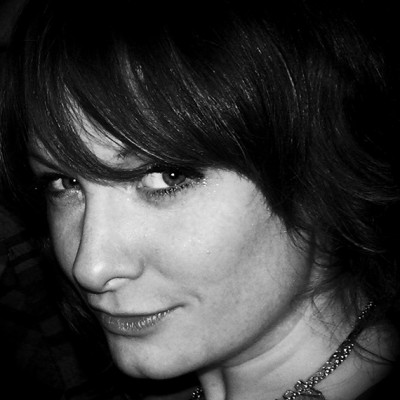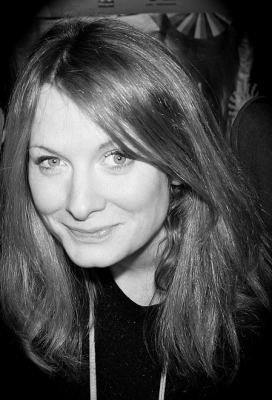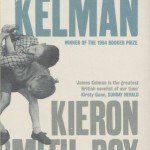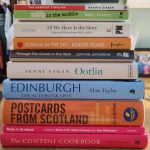Kirstin Innes discusses Fishnet, its follow-up and the art of writing with Naomi Richards
Support independent, non-corporate media.
Donate here!

Early afternoon in Glasgow city centre, Kirstin Innes and I are having lunch in Stereo, the popular vegan café/bar tucked away in Renfield Street. It seems a little strange to be chatting about prostitution, which may be why our voices are slightly hushed. On the table are mezze platters, coffee and a copy of Fishnet, Innes’ debut novel which won The Guardian’s Not the Booker Prize in 2015 and was listed as one of The Independent’s Top Ten Debut Novels in 2015. Fishnet follows the quest by Fiona, a university graduate languishing in a dull office job, to find her younger sister, Rona, who disappeared six years previously in Glasgow. Fiona discovers Rona has become a prostitute and is drawn into a world which she finds liberating and exciting. Open any page of Fishnet and there’s sharp, modern prose that explores the milieu of the sex worker; powerful, direct and at times disturbing, yet always honest. I’m interested as to how a writer deals with such taboo subjects and goes beyond simply shocking. The world of prostitution has many faces, other than – as the novel points out – the “hooker” cliché of fishnets.
NR: What was it that drew you to writing Fishnet?
KI: I used to be a journalist at a magazine, and I was asked by my editor to find women who did “edgy, sexy jobs” for a feature. In the course of that research, I came across the blog of an Edinburgh-based escort, and I was really struck by her voice. It jolted me. It was angry, political, aware – intelligent – not at all what I expected from the set of assumptions I’d gathered about sex workers from films and popular fiction. Her voice made me reconsider everything I thought I knew about the topic. She didn’t reply to me, I suspect because I sent her an incredibly embarrassing, naive email, and my editor nixed the interview – that particular job was a little too “edgy and sexy” for the magazine – but the voice stuck with me. I began following links from her blog to other sex worker activists, to the forums they advertise on, into this tangled virtual world with link upon link. I was fascinated: I became a sort of guilty voyeur lurking around the edges of this world for about a year, soaking it all in, until I finally plucked up the courage to approach one of them, an escort, blogger and sex workers’ rights activist called Laura Lee. She agreed to come out for lunch and we had a long conversation, and have stayed closely in touch since. From there, I was brave enough to approach other sex workers, talk to them both online and in person, and really get an idea of the realities of their working life.
NR: Gender assumptions are still strong including ideas about sex workers as victims of society.
KI: Meeting with and talking to these women really forced a change in my views. Before this, I would have said that, as a feminist, someone who understood they had “feminist principles” I was fundamentally opposed to sex work in all its forms. I thought I knew what that was, because everybody thinks they know what “prostitution” means – the stock pictures of legs up an alleyway, the dead body washing up at the start of a crime novel. It’s a sensationalised idea that bears very little relation to the world I began hearing about. It’s difficult to empathise with someone if you’re busy automatically pitying them; it’s difficult to pity someone who’s sitting across the table from you daring you not to. My position veered all over the place while I researched the book.
NR: I would imagine that sex work is a vast and often a secret world. You compare it to djinns – Indian spirits living in a world separate but close to our own world. It’s an interesting metaphor for the half visible world of prostitution all around us. Did that make it difficult for you to research the subject?
KI: My main character finds that sex work is everywhere and yet completely hidden until you start looking for it. It involves people from all walks of life. When I first started researching the book, in 2009-2010, it was all moving online and changing fundamentally, as for the first time sex workers had, in the internet, a space where their voices could actually be heard. Before the internet it was very difficult to get real life sex work experiences out there; because of the huge stigma around it, nobody really wanted to put their head above the parapet and identify as a sex worker. Now a lot of sex work activism takes place on Twitter, where there’s a strong, supportive internationally-reaching community. But alongside that, there’s the other side of the world – I was going into the forums where clients describe and rate their encounters with sex workers, and discovering some very ugly things.
NR: Some parts in the book are quite shocking particularly those client comments on prostitutes. There’ s a long tradition of sexually explicit novels, such as The Sexual Life of Catherine M to The Story of O, often considered the forerunner to Fifty Shades of Grey as well as memoirs about call girls, such as those by Belle De Jour. These books which blur fact and fiction are often very successful. Fishnet has a sort of documentary realism feel about it, the opposite of erotica. Why did you choose to write in this way?
KI: I wanted to be true to the nature of sex work as the women I’d spoken to had explained it to me; it can be very mundane, very ‘vanilla’, very un-erotic. The novel is also about the nature of work generally, especially the work done by women, and I wanted to also be true to what it’s like to be a low paid employee working in an office and sitting behind a screen all day, like my main character.
NR: Much of Fishnet reflects modern day internet usage and the language of computers with blogs, emails, reference to Flickr-tagged pictures, Myspace pages and texts messages between characters as well as a wide range of format and fonts. I particularly liked the section breaks marked by three bold XXXs as they looked like kisses or a triple XXX film. Is this a way of reaching out to the modern reader?
KI: Well, the book finishes in 2011, with most of the action happening in 2008-9, so the technology the characters are using is a little behind our own. But I feel if you want to represent contemporary life, especially in a textual form like a novel, you’ve got to try and represent the episodic nature of the way we take in information. Our thoughts are continually interrupted by pieces of textual information, interjections, text messages, emails, notifications. It was also important to me to try and get this across when dealing with a milieu like sex work, where so much of the business, the everyday administration of it, happens online. My main character is very introverted; she’s retreated into herself and she only really interacts with the world from behind a screen. I think that’s true to a certain degree for a lot of people, and I wanted to address that in the way I wrote about it. The XXX was a little joke – where some writers use an x to break up sections, I thought I’d nod to triple-X ratings.
NR: Fishnet is written in an episodic structure. Was it difficult to keep the novel thematically and structurally whole?
KI: It comes back to that idea of fragmented living, I think – I wanted to make the structure and form of the book feel true to the character’s stop-start, frustrated and confused experience. My narrator Fiona isn’t whole – she says that right at the start – that she and her family have an absence in them caused by her sister’s disappearance. She’s also withholding a lot of information, from the reader and from herself, so it made sense to have a structure where the story occasionally wheels back on itself, where it jumps between two separate sections. Administrating it was a bit of a fankle, though. When I was putting the novel together I went on a retreat, drew diagrams on huge sheets of paper with felt-tip pens, then stuck the paper up on the walls and windows in my room and moved them around until I got the structure right!
NR: It’s interesting that you were drawn to write Fishnet by being fascinated with an online voice. For some writers it’s an image or a phrase that they feel driven to explore…
KI: Partly. I did play around with having the central voice be a sex worker herself but I found the best way into the novel was to have a character from the outside step into this world. I was also particularly aware of assuming a position of knowledge about this world, when so much of the problem around sex workers’ rights is people presuming to speak for them, presuming that they can do that. I felt acutely that perhaps I didn’t have the right to assume that voice.

NR: Writers are often advised to write about what they know but maybe it’s as much about writing what you are drawn to and then figuring out how best to write it?
KI: Well, the novel certainly took a long time to write because it felt like such foreign territory. Sex work is a gigantic, complex issue spanning a multitude of different lived experiences, and despite having gone through this process I still feel conflicted about a lot of aspects of it. Eventually, I realised that the novel could only be so long and I needed to concentrate on one small area – the women who I could get to talk to me were independent escorts who advertise and blog online. I’ve spoken to people at talks I’ve done who have asked why I wasn’t covering street work, or why I wasn’t examining the particular dangers of rape and murder that sex workers face – and essentially I had to be true to what the sex workers I was meeting with were telling me, and compress my focus down on that. I’ve never claimed this novel is representative of a whole industry, but I think I stayed pretty true to my research. These women are just normal women – some of them are mothers, they all go to the supermarket, go about the same everyday lives as everyone else. Which is not to say sex work is all hearts and flowers, and I have tried to explore some of the more rotten aspects of the life, the misogyny from clients that sex workers have to deal with.
NR: Fishnet deals graphically with sex, female masturbation and other sort of taboo subjects, although the sex in the novel isn’t sexy, it’s down to earth and real. Did you have an idea of who your reader might be?
KI: Well, most fiction readers do tend to be female. I’m not totally sure I set out to write this with a picture of a reader in mind; I think that might have altered the way I was writing, made me much more self-conscious. But I was writing about the realities of having a female body, including the mundanities – I wanted to open up the tangentially-related topic of how we construct femininity, and how it’s pushed onto us. Fiona’s child, for instance, was originally a boy, but I thought it was much more pertinent to examine how little girls get socialised into the business of womanhood from early on. Male readers have flagged up that they were surprised by the relative lack of male characters in the book, and I suppose it’s true that there aren’t as many as in your average novel (whenever I hear this I do feel that the fellas have had the whole of Western literature to themselves for a couple of thousand years and can probably cope with one book about women).
NR: Did you find getting a publisher difficult?
KI: My agent picked up my book very quickly, but it took three months to get a publisher on board – the larger publishers who were interested all wanted to make substantial changes to the book that would have gone against my research and my aims in some way, whether that was upping the shock content of the book, or marketing it as a crime novel. With a small publisher like Freight, I had more editorial control – they were happy to take the manuscript almost as-was, because they believed in the book, which was great.
NR: Nowadays, everything in some ways is so open, as you said, ‘Anyone can find anything they want, instantly, any story they want to believe in, any pictures they need to see. It’s all there. Almost.’ Yet Fiona most wants to find her sister, who remains elusive. What drew you to writing about sisters?
KI: I’m not really sure – I don’t have a sister, so didn’t have any particularly personal reasons for this topic. The original nub came from a scene I wrote between two sisters when playing around with an idea in a creative writing class at university, years ago. That part where one sister disappears and leaves her baby with the other – that eventually made it into Fishnet, heavily edited to take all my studenty posing out of it! But at the time of writing the scene I wasn’t sure what I was going to do with it, so I just tucked it away.
NR: Yes, writing is like that, stitching things together later on. I was also thinking of Barbara Vine’s book A Dark Adapted Eye, about two sisters who were very close but one could have children and the other couldn’t. The childless sister tries to take custody of her nephew and her fraught desires compel her to murder her sister. Did you ever think there might be jealousy with one sister leaving a baby with another?
KI: Well, there is – that jealousy, and the resentment she feels towards the absence of Rona underpins a lot of Fiona’s actions throughout the book; even as she’s trying and failing to find her sister you’re not sure why she wants to – is it for entirely the right reasons?
NR: Do you think writers today have to have an eye on the market when they’re writing? You mention the credit-crunch in your novel, how do you think this has affected artists? Are they taking fewer risks?
KI: It’s very hard to get time to write, and I think that’s an economic reality for most writers. Novelists, for the most part, don’t get big advances any more, as fewer and fewer people are actually reading, so most writers I know have other jobs that have to be negotiated around in order to get writing done too. I feel enormously-privileged to have support from Creative Scotland for my next novel. I don’t know whether writers are taking fewer risks, but publishers certainly are – you see a lot less experimental fiction being published, although there was Eimear McBride’s debut novel A Girl is a Half-formed Thing in 2013.
NR: What’s your next book about?
KI: I’m writing a novel about female left-wing political activism. It’s called Scabby Queen and it takes in four decades in one woman’s life, from the 1980s, during the miners’ strike, finishing in 2018. I was interested in writing about a female character who refuses to settle down or conform, who makes lots of intense friendships then moves on quickly. ‘Scabby Queen’ is a card game – a violent, Scottish version of Old Maid, where the aim is to get rid of the queen, who is passed among the players, and I’m writing it from the differing points of view of people who have been involved with this woman over the years. I’m also co-writing a play with my partner, about infertility and the way we don’t talk about that in society, called Just try to relax.
NR: The clarity and precision of your language reminds me of Janice Galloway, especially her short story Blood about going to the dentist…
KI: I was definitely influenced by Janice Galloway, particularly ‘Blood’ and The Trick is to Keep Breathing. Also A. L Kennedy for the pared-back quality of her writing; Gary Shteyngart’s novel Super Sad True Love Story, is written through emails and diaries, and is a look at that fragmented computerised world we live in, similarly the digital texts in Jennifer Egan’s A Visit From The Goon Squad.
XXX









